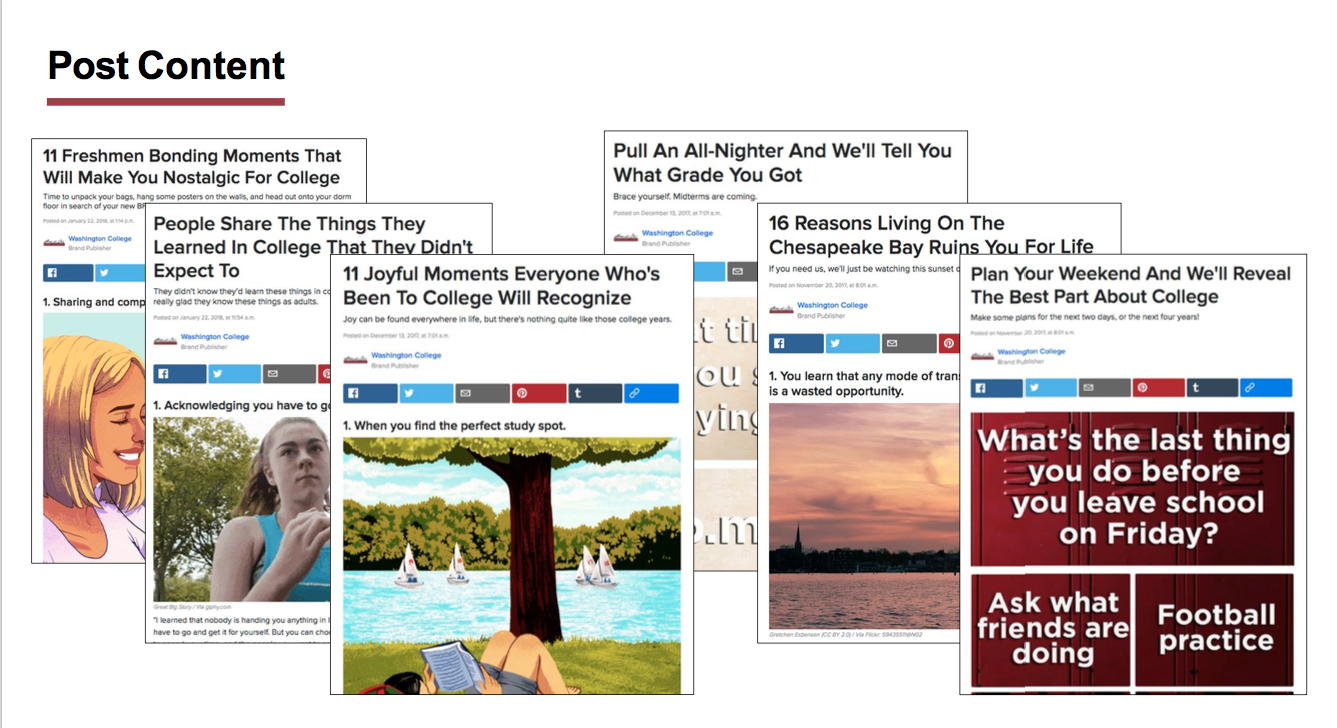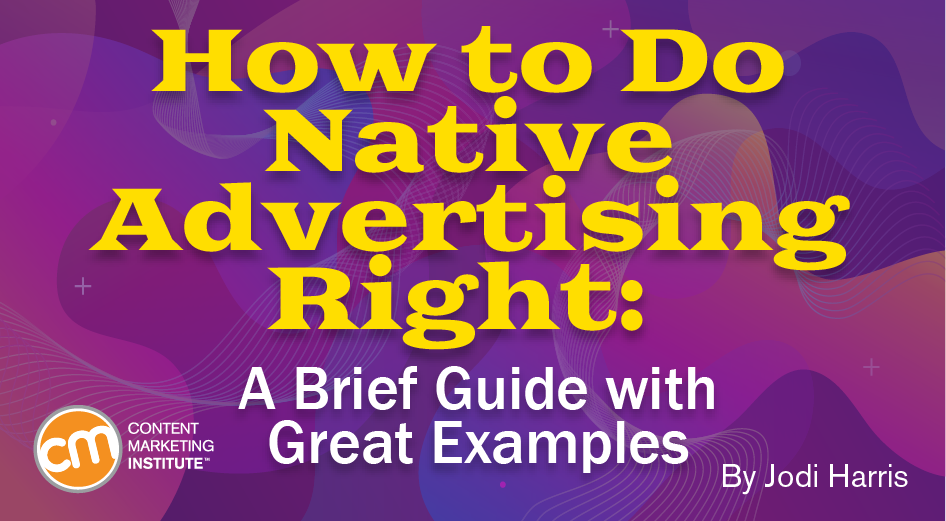
As someone who started her content career in traditional journalism, I took some time to come to terms with the concept of native advertising. I bristled at the thought of paid ads masquerading as editorial content, violating the church-and-state division I was taught.
But, like it or not, the rules of publishing have changed. The lines between media and marketing have blurred, and brands have more power, influence, and opportunities to communicate directly with audiences. And new tools and strategies have emerged and disrupted the game.
Like any good species in a survival-of-the-fittest world, I’ve come around to see significant value in native advertising – when it’s executed smartly and strategically.
What is native advertising, in a nutshell
As Robert Rose, CMI’s chief strategy advisor, recently explained, the classic term for native advertising is “advertorial” – an advertisement in a newspaper or magazine appearing in the style of an editorial or journalistic article. But, with the prevalence of digital media, marketers’ view of the technique and how it can be applied has expanded, and with it, so too has CMI’s definition:
Native advertising is a paid/third-party advertising format that supports either brand or direct-response goals, and is where the content matches the form, feel, function, and quality of the content of the media on which it appears.
Let’s unpack that, looking at the three defining principles at play in native ads:
- They are a direct-paid opportunity. Native advertising is pay to play. Brands pay for the placement of content on platforms outside of their owned media properties.
- They’re typically information-based rather than overtly product-focused. Ideally, the content in a native campaign should be useful, interesting, and highly targeted to the media channel’s audience.
- They’re delivered in stream. Native advertising doesn’t disrupt the user experience because it’s featured in a way that does not impede the user’s normal behavior on that channel.
Think of native advertising as a way of distributing your high-quality content so it can get discovered by consumers who might not yet know enough about your brand to engage with that content on your owned media channels.
Types and transparency tips
Though native ads can take many forms, these are most commonly used in content marketing:
- In-feed units appear alongside other content in a news feed or list of content. They are built to look and function like organic posts. (Some social channels offer additional features to business clients that regular users can’t access.) A sponsored post in your Instagram or Facebook feed is a great example of this format.
- Search ads appear in stream and match the form and function of other entries on a search engine results page (SERP). These narrowly targeted placements are most commonly used to drive a direct response – a sale, download, or data capture.
- Recommendation widgets create a designated spot for sponsored stories to appear on a site’s pages, usually underneath or alongside the site’s organic editorial content.
- Paid blog posts are a native opportunity offered by many larger media companies through their blogging partnership platform (Forbes’ BrandVoice is one prominent example). Published on a co-branded site page, these efforts are designed to appear more like collaborative, ongoing thought leadership than one-shot promotional spots. They hold appeal for audiences looking to dive more deeply into relevant, news-related topics.
Base decisions on which units to use on your strategic content marketing goals, as well as the capabilities of your target publication. Regardless of the format, native advertising campaigns must follow the same disclosure rules that govern other advertising. You’ll find the FTC guidelines here. Pay attention to these core principles:
- Do not try to deceive the audience or misrepresent the nature of these promoted materials in any way.
- Identify clearly and prominently any sponsored or branded content (i.e., clearly label it as advertising).
- Disclose prominently any clarifying information to avoid deception (e.g., the content comes from your brand and not the publisher).
HANDPICKED RELATED CONTENT:
A native edge
Native ads are designed to give your content greater visibility than it might receive on your owned channels. They also provide greater relevance and authority than other digital advertising. Native ads achieve this in two key ways:
- Placing your content on trusted and reputable information sources offers a strong potential to engage a broader audience. Because the content is built to share brand insights and perspectives rather than to hawk your wares, it’s more likely to plant seeds of positive perception for your business in the minds of audience members.
- The implied endorsement from those publishing sites helps your content break through the “banner blindness” that increasingly occurs with digital advertising.
Native advertising also offers a high degree of creative flexibility. You can incorporate text, video, photos, data visualizations, and even interactive features into your native ad campaigns. You can provide a rich, engaging content experience that blends into the publisher’s organic offerings. And, because native advertising campaigns are often managed through the publisher’s versatile self-service tools, they can be developed, launched, and optimized quickly, and customized to fit just about any budget.
Unlike banner ads or customized, co-produced branded content initiatives, native ads are an ideal way to repurpose content. You don’t necessarily need to develop new assets (though you certainly can, as you’ll see in the Washington College example below).
Native ads are an ideal way to repurpose #content, says @joderama. Click To TweetIncidentally, if you want a comprehensive explanation of where native advertising fits on the content marketing spectrum, check out this fantastic explainer video by Robert:
Native ad success
To achieve the best results, do research before unleashing your content on an unsuspecting audience. Many publishers use auction-based automated systems to determine where and when native campaigns appear. If you select content that doesn’t align with user intent or fail to configure your campaigns carefully, your brand might end up in the wrong place at the wrong time – or get noticed for the wrong reasons.
Select #content that aligns with user intent for #nativeadvertising success, says @joderama. Click To TweetFor example, in her presentation at Content Marketing World, StoryFuel founder Melanie Deziel described her experience of looking for wedding gown ideas on Pinterest. During her search, a pin sponsored by Dick’s Sporting Goods appeared. The native ad copied the format of the pins around it. Unfortunately, the content of the ad – hot-pink running shorts – clashed with Melanie’s intent that day. “It left a bad taste in my mouth,” she says.

How can brands create eye-catching, authentic, and click-worthy native advertising that is as compelling as the organic content experience audiences expect from their favorite media sites? Look at a few standout examples:
Washington College plants some seeds of love on BuzzFeed
Aspiring to connect with the lives of high school students starting to consider their college options, Washington College partnered with youth-friendly media site BuzzFeed on a series of native posts focused on the theme You’ll Love This Place. The topics spanned from life on Chesapeake Bay to incredible experiences as a freshman in college. The native ads were distributed across BuzzFeed’s website and multichannel social media properties, giving the posts massive reach, easy shareability, and mobile accessibility.

According to Washington College, the campaign resulted in a 77% page-view increase on Facebook and a 94% page-view increase to its website home page (year over year). It also generated 373 application inquiries on enrollment and earned the college a 2018 Content Marketing Award for native advertising/sponsored content.
Santander’s native efforts lead customers through a journey of continual relevance
In his Content Marketing World presentation, Native Advertising Institute CEO Jesper Laursen shared an excellent case study of how Spain-based financial services company Santander combined native and traditional advertising to attract new leads and support informational needs from awareness through conversion.

Here are details on how the process worked:
(1) Prospect sees a sponsored article about how home improvements make a house more valuable, shared by Santander on Facebook.
(2) Prospect reads a related article from Santander about how to get the best interest rates when borrowing for a home-improvement project.
(3) Santander drops a cookie on a reader’s computer and retargets him or her with display ads on other sites.
(4) Prospect clicks on a display ad to read about getting a home-improvement loan.
(5) Prospect conducts a search on Google where a native-search ad leads the person to Santander’s website to start the loan application.
Abbvie adds an authentic native voice to an essential health care conversation
Ulcerative colitis (UC) is not a sexy topic that generates casual attention or open discussion. But to those who feel isolated because of their UC symptoms, hearing from others successfully managing the disease can help open their eyes to the benefits of treatment.
Recognizing the value of connecting with its target audience more personally than a typical ad spot could manage, pharmaceutical company Abbvie rose to its marketing challenge with a series of sponsored video posts for The Los Angeles Times. Each post features patient stories that someone who lives with UC can likely relate to. Collectively, the campaign speaks to the brand’s goal of inspiring sufferers to act toward achieving remission.

10% Happier exercises creativity to illustrate value
If you’re on Instagram, you scroll past dozens of ads each time you check your feed. But brands are realizing it’s harder to pass by their promotions if they beg for your attention with a fun interactive activity. I recently came across a sponsored spot for the 10% Happier app, which challenged me to focus on a frantically bouncing red dot for 10 seconds as a lead-in to learning more about gaining greater focus through meditation.

How do you plan to go native?
These examples illustrate a few ways native advertising can be used to help brands increase their content’s visibility, build an engaged audience, and move their marketing goals forward. If you’ve seen efforts that inspired you to consider this technique – or have more questions about how to add it into your marketing mix, we’d love for you to share your experience in the comments.
Are you growing or refocusing your content marketing mix? Get the upper hand by expanding your content marketing skills. Enroll in the spring semester of Content Marketing University before the March 31 deadline.
Cover image by Joseph Kalinowski/Content Marketing Institute

